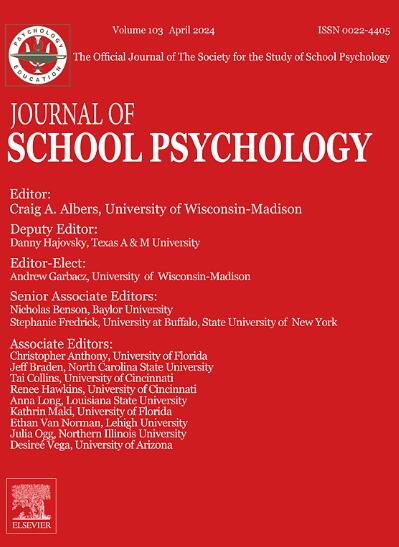Identifying common practice elements among consultation studies showing promising social and behavioral outcomes: A systematic review
IF 4.1
1区 心理学
Q1 PSYCHOLOGY, SOCIAL
引用次数: 0
Abstract
Consultation is a key service delivered by school psychologists that can reduce the burden of mental health problems and promote healthier school climates given its emphasis on problem solving, prevention and intervention, and supporting educator skill and competence. The purpose of this systematic review was to document how demographic and study design information was reported in the school consultation research and to identify common practice elements that cut across consultation outcome studies with promising student social and behavioral outcomes. We examined 48 studies (39 group design and 9 single-case design) published between 1980 and 2024 and applied a distillation method (Chorpita & Daleiden, 2009) to summarize demographic and study designs employed and to identify specific practice elements that emerged. Seventy-two percent of studies included students receiving tier two supports as the target for consultation. Forty-three percent of studies included graduate students as consultants, while only 10.4 % of studies included school psychologists as consultants. Demographic characteristics of consultants (i.e., gender reported 33.3 % and race/ethnicity reported 27.1 %) was less frequently reported when compared to the demographic characteristics of consultees and students. At the teacher level, consultant modeling (present in 58.3 % of studies) was the most common practice element, followed by performance feedback (56.3 %), and family engagement (41.7 %). At the student level, praise (present in 56.3 % of studies) was the most common practice element, followed by goal setting (52.1 %), functional behavioral assessment, and tangible rewards (47.9 % of studies). The relative infrequency with which some practice elements were coded (e.g., praise for teacher, cultural adaptation for teacher and student) point to avenues for enhancing school consultation research and practice.
在显示有希望的社会和行为结果的咨询研究中确定共同实践要素:系统回顾
咨询是学校心理学家提供的一项关键服务,它强调解决问题、预防和干预以及支持教育工作者的技能和能力,可以减轻心理健康问题的负担,促进更健康的学校氛围。本系统综述的目的是记录在学校咨询研究中如何报告人口统计和研究设计信息,并确定在咨询结果研究中有希望的学生社会和行为结果的共同实践要素。我们检查了1980年至2024年间发表的48项研究(39项组设计和9项单例设计),并应用了蒸馏法(Chorpita &;Daleiden, 2009)来总结所采用的人口统计学和研究设计,并确定出现的具体实践元素。72%的研究将接受二级支持的学生作为咨询对象。43%的研究将研究生作为顾问,而只有10.4%的研究将学校心理学家作为顾问。与咨询者和学生的人口统计特征相比,咨询者的人口统计特征(即,性别报告33.3%,种族/民族报告27.1%)的报告频率较低。在教师层面,顾问建模(出现在58.3%的研究中)是最常见的实践元素,其次是绩效反馈(56.3%)和家庭参与(41.7%)。在学生层面,表扬(在56.3%的研究中出现)是最常见的练习元素,其次是目标设定(52.1%),功能行为评估和有形奖励(47.9%的研究)。一些实践要素编码的频率相对较低(例如,对教师的赞扬,教师和学生的文化适应)指出了加强学校咨询研究和实践的途径。
本文章由计算机程序翻译,如有差异,请以英文原文为准。
求助全文
约1分钟内获得全文
求助全文
来源期刊

Journal of School Psychology
PSYCHOLOGY, EDUCATIONAL-
CiteScore
6.70
自引率
8.00%
发文量
71
期刊介绍:
The Journal of School Psychology publishes original empirical articles and critical reviews of the literature on research and practices relevant to psychological and behavioral processes in school settings. JSP presents research on intervention mechanisms and approaches; schooling effects on the development of social, cognitive, mental-health, and achievement-related outcomes; assessment; and consultation. Submissions from a variety of disciplines are encouraged. All manuscripts are read by the Editor and one or more editorial consultants with the intent of providing appropriate and constructive written reviews.
 求助内容:
求助内容: 应助结果提醒方式:
应助结果提醒方式:


